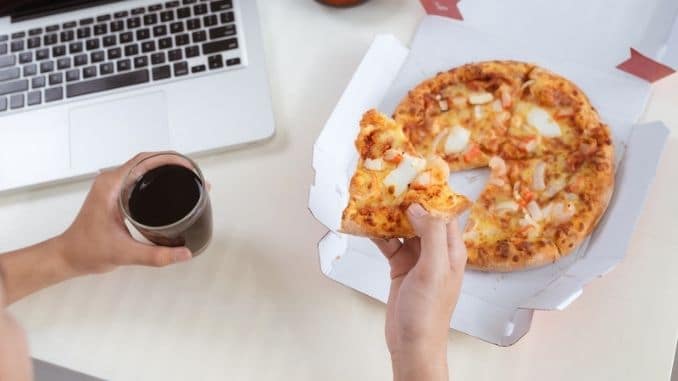
You’ve had a long day at work. Finally, you get home, kick off your shoes, grab a box of your favorite snack crackers, and sit down to watch your favorite TV show.
Ah, it feels so good to finally be able to relax. You watch. You eat. You eat some more. Before you know it, you’ve reached the bottom of the box.
How did that happen?
You’ve just experienced “mindless snacking,” which is often accompanied by guilt. You didn’t mean to eat that much!
To avoid ever having to feel this way again, try our tips below to end mindless snacking for good.
What is Mindless Snacking?
Mindless snacking or mindless eating is basically eating while you’re distracted by something else. So, you may eat while watching television, scrolling through your social media feed, working, driving, or chatting with friends.
When we eat this way, several things happen that contribute to overeating.
- We don’t really “experience” the food. We simply chew and swallow without really registering how the food tastes or feels in our mouths because our minds are focused on something else.
- We eat more. Since we’re not paying attention to our food, we tend to eat more than we usually would. Cues like hunger and satiety fail to get our attention, so we continue putting the food in our mouths without asking ourselves if we’re still hungry.
- We use the food for something besides energy. Instead of eating to fortify our bodies, we eat for other reasons. We want something to do while watching TV, for instance, so we reach for the Cheetos. We feel stressed out, so we eat to feel better. We’re bored while driving so we eat to ease that boredom. All these other emotions come into the picture and override any feelings of fullness.
In essence, while mindlessly snacking, we’re operating on auto-pilot. We don’t know how much we’re eating and often don’t know why. We’re just eating.
Unfortunately, the result is often weight gain and poorer overall health.
Mindless Snacking Leads to Weight Gain
Research shows that mindless eating is bad for your waistline. In a recent review, researchers analyzed 24 studies and found that while mindless or distracted eating resulted in increased calories consumed, attentive eating produced the opposite effect.
In another study, researchers divided participants into four groups:
- Group 1 ate while driving.
- Group 2 ate while watching television.
- Group 3 ate while interacting with others.
- Group 4 ate alone while taking part in a taste test.
Results showed that those watching television while eating ate the most—more than those driving, interacting socially, or eating alone.
Eating “on the go” is another type of distraction that can lead to eating more. In a 2015 study, researchers found that those who ate while walking or going from one place to another tended to eat more later in the day. The researchers concluded that eating on the run disrupted hunger cues and could lead to weight gain.
In yet another study, people who ate lunch while watching TV or playing games on a computer ended up snacking more later compared to those who were attentive and mindful about their meal.
So, what does it mean to eat mindfully rather than mindlessly?
What is Mindful Eating?
Eating mindfully is the opposite of eating mindlessly. Rather than eating while on the run, watching TV, or doing something else, you bring all your focus to the meal or snack in front of you.
You pay more attention to how it looks, tastes, and feels. You take time to think about what went into its preparation. You smell it before putting it into your mouth, and when you do take a bite, you savor the taste and texture, chewing slowly before you swallow.
The point is to slow down, relax, and gain all the enjoyment you can from eating. By doing this, you tune into your body and your senses, which helps you better determine when you’ve had enough. This type of eating can help you cut back on calories consumed, and ultimately, to lose weight.
In a 2011 study, researchers split participants into three groups:
- Group 1 ate lunch while focusing on the sensory characteristics of the food as they ate.
- Group 2 ate lunch while reading a newspaper article about food.
- Group 3 ate without doing any other activity.
All three groups were then offered cookies later in the afternoon.
Results showed that those in group 1 ate significantly fewer cookies later in the day than those in groups 2 or 3. They also reported being less hungry.
In a later study of 194 adults with obesity, researchers found that increases in mindful eating were associated with decreased eating of sweets and fasting glucose levels among participants.
So, if you want to cut back on mindless eating and snacking, follow these tips:
- Set aside times to eat and snack. Don’t do either while doing something else.
- Start with the smallest portion possible. Always put your meal or snack on a plate or in a bowl. Never eat directly out of the packaging.
- Pay attention to what you are eating.
- Eat slowly, savoring every bite.
- Every few minutes, ask yourself, “Am I still hungry?” Range your hunger on a scale of one to 10, with 10 being full. If you’re still at a three or four, go ahead and eat, but when you get to six or seven, stop and wait. It takes up to 20 minutes for your brain to register that you’re full.
10 More Ways to Stop Mindless Snacking
Through mindful eating is your best defense against mindless snacking, there are other things you can try as well.
1. Use smaller dishes.
In a 2015 review, researchers found that smaller dishes, containers, and cutlery could help adults consume up to 29 percent less.
2. Have fewer options available.
Having a large variety of snacks available makes it easier to eat more. In other words, if you get out the nuts, chips, crackers, and cookies, you’ll likely eat more than if you get out the crackers only. Or if you fill a bowl with a variety of different types of candies, the same result occurs.
Having fewer options, on the other hand, can help you eat up to 23 percent less.
3. Control your portions.
As noted above, eating straight out of the container pretty much guarantees that you will eat too much. Instead, control your portions. Pour a few crackers out on a plate and then put the box away. Or put a few chips in a bowl and put the bag away. Or buy some of those 100-calorie pre-packaged snacks. This helps you in a couple of ways.
First, you remove the temptation to just keep eating and eating out of the bag or box. Second, you see exactly what you’re eating, which increases your awareness and helps you avoid overeating.
4. Drink a glass of water first.
Water is filling, so if you make it a habit to drink a glass of water every time before you snack, you’ll help yourself to eat less. If you keep a glass of water nearby while you’re snacking, as well, and sip occasionally, it will help remind you to slow down and eat more mindfully.
5. Clean up your eating area.
When you crave a snack, tidy up your eating area first. Clean off the table, put all the dishes in the dishwasher, and wash off the counter before you snack. This can help bring awareness to what you’re doing, which will help you eat less. Plus, a well-kept environment helps improve mood, which may reduce hunger.
6. Journal.
Before you reach for that snack, grab your phone, computer, or a pad and pen, and take five minutes to write down how you’re feeling at that moment. Journaling is a proven technique for relieving stress and processing emotions and can help you avoid mindless snacking. Don’t worry about grammar or spelling, just free write for five minutes and then see if you still want to snack. If so, you’ll likely approach it more mindfully.
7. Keep your favorite snacks high up.
The more work you have to do to get your food, the easier it is to avoid eating too much. If you store your favorite snacks upstairs on a high shelf in the closet, for instance, you have to climb the stairs, get the stepstool, and reach up into that closet to get what you want. Just the thought of all that effort may convince you to wait for a while.
If you are hungry enough to follow through on retrieving your snack, you will have brought your mind to the task through all the activity, which can help you eat more mindfully.
8. Ask the question: Am I really hungry?
Mindless snacking is rarely about hunger. More often, we snack because we’re bored, stressed, or worried about something. Before you start mindlessly eating, stop and ask yourself, “Am I really hungry?” Give yourself a moment to scan your body so you can answer that question, then proceed. Many times, you may find that this short pause allows you to address what’s really going on. If you’re stressed, for example, it may be better to go for a walk than to eat.
9. Treat your snack like a meal.
Don’t take it to the couch. Instead, put your snack on a plate or in a bowl, get a glass of water, and sit at the table. Put your phone away and focus solely on eating. This is a great way to determine if you were hungry or not. If you were, you’ll enjoy eating the snack. If you weren’t, you will probably find it boring and want to go do something else.
10. Choose a zero-calorie beverage.
If you need a snack but you don’t want to overeat, choose a zero-calorie beverage instead. Your healthiest options are water, sparkling water, flavored water, tea, and coffee. Artificially sweetened sodas have been found in some studies to contribute to cravings and weight gain, so it’s best to avoid those. If you need something more substantial, try a low-sodium vegetable drink or a small serving of 100 percent juice.
Let’s face it – most of us enjoy snacking, and when done mindfully there is no harm in doing so. The key is awareness. Take the necessary steps to keep your snacking sensible. Make better choices and decrease any opportunities for mindless munching.
Learn the natural way to slim and heal your body. Click here for more information.








